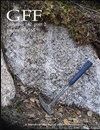The complexity of mudstone diagenesis – some insight from the Tøyen Shale, Lower to Middle Ordovician, southern Sweden
IF 1.2
4区 地球科学
Q2 GEOLOGY
引用次数: 1
Abstract
ABSTRACT The Lower to Middle Ordovician Tøyen Shale in southern Sweden, a biostratigraphically well-dated siliciclastic mudstone unit, shows 18 distinct authigenic cements that include sulfides, carbonates, silicates, clays, and phosphates. Marcasite, sphalerite, galena, and six texturally distinct types of pyrite characterize the sulfides whereas only one type of dolomite and three different generations of calcite are observed in this unit. Quartz, phosphate, and organic matter occur as only one generation each. Authigenic clay minerals are represented by chlorite and kaolinite. The paragenetic sequence of cements is subdivided into the two pre-burial carbonates, succeeded by ten relatively early burial cements, and six late burial cements, the kaolinite being the latest of them all and potentially being of Cretaceous age. Based on textural relationships, the paragenetic sequence of alterations started with dolomite precipitation followed by calcite, and then five different generations of pyrite. All eleven other phases post-date these initial seven cements in the Tøyen Shale.泥岩成岩作用的复杂性——从瑞典南部下奥陶世至中奥陶世的Tøyen页岩中获得的一些见解
摘要瑞典南部的下奥陶世至中奥陶世Tøyen页岩是一个生物地层学上年代确定的硅化碎屑泥岩单元,显示了18种不同的自生胶结物,包括硫化物、碳酸盐、硅酸盐、粘土和磷酸盐。Marcasite、闪锌矿、方铅矿和六种结构不同的黄铁矿是硫化物的特征,而在该单元中只观察到一种类型的白云石和三代不同的方解石。石英、磷酸盐和有机物只产生一代。自生粘土矿物以绿泥石和高岭石为代表。胶结物的共生序列分为两个埋藏前碳酸盐岩,其次是十个相对早的埋藏胶结物和六个晚的埋藏胶结体,高岭石是所有胶结物中最晚的,可能是白垩纪。根据结构关系,蚀变的共生序列从白云石沉淀开始,然后是方解石,然后是五代不同的黄铁矿。所有其他十一个阶段都是在Tøyen页岩中最初的七种水泥之后。
本文章由计算机程序翻译,如有差异,请以英文原文为准。
求助全文
约1分钟内获得全文
求助全文
来源期刊

Gff
地学-地质学
CiteScore
2.80
自引率
10.00%
发文量
11
审稿时长
>12 weeks
期刊介绍:
GFF is the journal of the Geological Society of Sweden. It is an international scientific journal that publishes papers in English covering the whole field of geology and palaeontology, i.e. petrology, mineralogy, stratigraphy, systematic palaeontology, palaeogeography, historical geology and Quaternary geology. Systematic descriptions of fossils, minerals and rocks are an important part of GFF''s publishing record. Papers on regional or local geology should deal with Balto-Scandian or Northern European geology, or with geologically related areas. Papers on geophysics, geochemistry, biogeochemistry, climatology and hydrology should have a geological context. Descriptions of new methods (analytical, instrumental or numerical), should be relevant to the broad scope of the journal. Review articles are welcome, and may be solicited occasionally. Thematic issues are also possible.
 求助内容:
求助内容: 应助结果提醒方式:
应助结果提醒方式:


